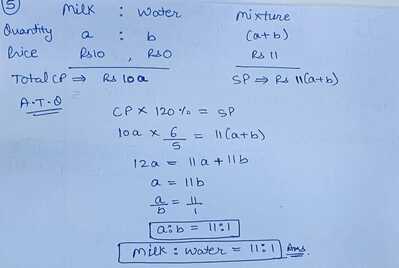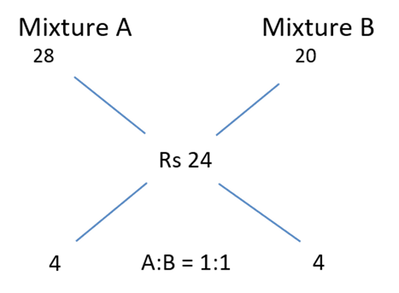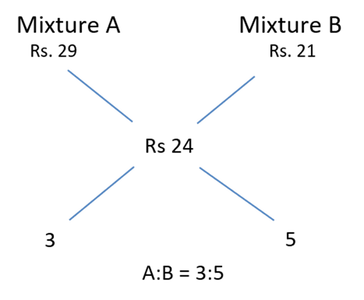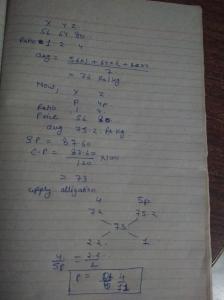A pack of 240 ml, mixture of wine and water contains in the ratio 5: 7. How much wine must be mixed in the pack, so that the ratio of wine and water in the pack becomes 5:4?
- A) 75 ml B) 100 ml C) 115 ml D) 125 ml
Q.) From a container filled with milk, 9 litres of milk are drawn and replaced with water. Next, from the same container, 9 litres are drawn and again replaced with water. If the volumes of milk and water in the container are now in the ratio of 16 : 9, then the capacity of the container, in litres, is
Answer:- Let’s assume the capacity of the container is ‘c’
Let’s track down the milk which is retained.
The milk retained after taking first 9 litres from the container is (c × (c−9)/c )
The milk retained after taking next 9 litres from the container is ( c × (c−9)/c × (c−9)/c )
The volumes of milk and water in the container are now in the ratio of 16 : 9.
The milk in the container is 16/25
{c×(c−9)/c×(c−9)/c}/c = 16/25
{(c−9)/c}2 = 16/25
(c−9)/c = 4/5
c = 45(Ans)
A salesman mixes some water to milk and sells this mixture at 10% above the cost price of milk and did a profit of 20%. If the cost price of milk is Rs10 per liter, then what is the ratio of milk to water in this mixture?
Q1. A chemist mixes two liquids 1 and 2. One litre of liquid 1 weighs 1 kg and one litre of liquid 2 weighs 800 gm. If half litre of the mixture weighs 480 gm, then the percentage of liquid 1 in the mixture, in terms of volume, is ?
In Liquid L1 - 1L = 1000 grams
So, 1000 mL = 1000 grams
1 mL = 1 gram
x mL = x grams
In Liquid L2 - 1L = 800 grams
1000 mL = 800 grams
1mL = 0.8 grams
(500-x) mL = (500-x) x 0.8 grams
Total mass = x + 400 - 0.8x = 480 grams
0.2x = 80 grams
x = 400 grams
Therefore, Liquid 1 has 400 mL and Liquid 2 has 500 - 400 = 100 Ml
A trader sells 10 litres of a mixture of paints A and B, where the amount of B in the mixture does not exceed that of A. The cost of paint A per litre is Rs. 8 more than that of paint B. If the trader sells the entire mixture for Rs. 264 and makes a profit of 10%, then the highest possible cost of paint B, in Rs. per litre, is
Given, The amount of B in mixture ≤ Amount of A in mixture
Selling Price = Rs. 264 and Profit = 10 %
264 = 1.1 × CP
CP = 264/1.1 = Rs. 240 for 10 litres
CP per litre = Rs. 24
We also know that, CP per litre of A = CP per litre of B + 8 Let CP per litre of B = x So, CP per litre of A = x + 8
Given Amount of B ≤ Amount of A,
Maximum possible cost of B occurs when B = A
We need to choose values for A and B in such a way that the quantities remain same.But A should be 8 more than B
Therefore, A should have a CP per litre of Rs. 28 and B should have a CP per litre of Rs 20
B cannot be assigned any more than this as the amount of B would become more than A
Example: Let us assign B to be Rs. 21 and A to be Rs. 29 which would result in a ratio of 3:5 where B amounts more than A, which doesn’t satisfy the condition
Max possible cost of Paint B = Rs. 20 per litre
Wine = 100 ml, water = 140 ml
(100 + x) /140 = 5/4 => 100 + x = 175
x = 175 - 100 = 75 ml
Hello Ananya,
Please find the solution.
One sample of milk contain 22.22% of water by volume, while the other sample of milk contain 20% of water by volume. A glass is filled with 5 parts of first sample and 7 parts of second sample. Find out the percentage volume of the water in the mixture.
Hello Samyak ,
22.22% = 2/9 , 20% = 1/5
using allegations
2/9 1/5
k
5 7
=> (2/9 - k)/(k -1/5) = 7/5
k = 113/540
Hence , 20.9 %
A local grocer mixed 3 qualities of coffee X , Y , Z at Rs. 56 per kg , Rs, 64 per kg and Rs. 80 per kg in the ratio 1:2:4. To 4 kg of this mixture , he added p kg of X and 4p Kg of Z .The final mixture so formed is sold for Rs. 87.60 per kg at 20% profit. Find p.
What are the options ?
Answer is 4/11 ?
Does the Copy NMAT also has a deadline like the copy CAT's within which we have to attempt the exam?
A shopkeeper bought two kinds of wheat. The per kg rate of dearer wheat is 25% more than that of the cheaper wheat. In what ratio should the cheaper and the dearer wheat be mixed by the shopkeeper so that if he sold them at the per kg rate of dearer wheat , he has a gain of 10% per kg?
let the cheaper rate be 100 than dearer rate becomes 125(25% more than cheaper its given)
now we have to sell on the dearer rate( sp=250) and the profit should be 10%
so the cp=125*100/110 =1250/11
now apply alligation
100 125
1250/11
125/11 150/11
5 : 6 (eq ratio)
A tank contains 20 litres of pure milk . Mr B takes out 4 litres of milk from the tank and replaces it with water . Then again he takes out 4 litres of mixture of milk and water and replaces it with water . He repeates this process four times . Then , the final amount of water left in the tank is ?
4 lt taken out from 20 so 1/5 part remaining milk =4/5 ,
this process is done for four times
milk remained=20*(4/5)^4
water= 20-milk
solve and get answer
Three solutions of Bhang have respective content of 1% , 2% , & 3% concentrated bhang . If Ravi wants to make a 1.5% solution , the ratio of solution 1 to solution 2 to solution 3 must be maintained at ?
let the ratio be x:y:z
(1*x+2*y+3*z)/(x+y+z)=1.5
solving this we will get this equation
y+3z=x (option c satisfies this equation)
but,
by putting random values of y and z and we will get different x
so there will be no. of solutions
ratio of water and syrup=3:5
total quantity =8
new ratio should be 1:1
for equal quantity ratio =4:4
part of water replaced will be same as the quantity of syrup taken out
part of syrup taken out=5-4/5=1/5
part of water replaced =1/5 (option c)







